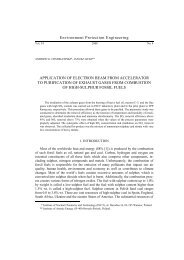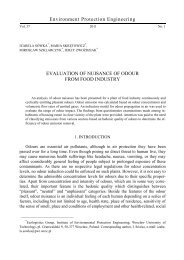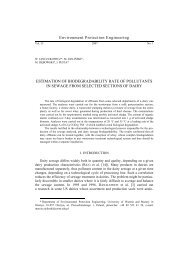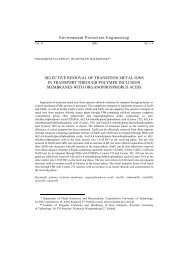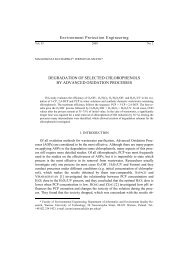Removal of organic matter from surface water by PAC-adsorption
Removal of organic matter from surface water by PAC-adsorption
Removal of organic matter from surface water by PAC-adsorption
Create successful ePaper yourself
Turn your PDF publications into a flip-book with our unique Google optimized e-Paper software.
Environment Protection Engineering<br />
Vol. 33 2007 No. 1<br />
MAŁGORZATA SZLACHTA*, WOJCIECH ADAMSKI*<br />
REMOVAL OF ORGANIC MATTER FROM SURFACE WATER<br />
BY <strong>PAC</strong>-ADSORPTION<br />
This paper presents the results <strong>of</strong> the efficiency <strong>of</strong> sorption <strong>of</strong> natural <strong>organic</strong> <strong>matter</strong> (NOM)<br />
<strong>from</strong> the Odra River <strong>water</strong> on powdered activated carbon Norit SA Super. The kinetic curves and <strong>adsorption</strong><br />
isotherms <strong>of</strong> dissolved <strong>organic</strong> compounds, expressed as dissolved <strong>organic</strong> carbon (DOC)<br />
and absorbance at the wavelength <strong>of</strong> 254 nm (UV 254), have been included. The paper also describes<br />
the character <strong>of</strong> the porous structure <strong>of</strong> the powdered activated carbon (<strong>PAC</strong>) particles.<br />
1. INTRODUCTION<br />
Surface <strong>water</strong> typically contains anthropogenic pollutants which pose a major<br />
threat to the environment. These are polycyclic aromatic hydrocarbons, <strong>surface</strong>-active<br />
agents, phenols and their derivatives, pesticides, radionuclides or heavy metals, to<br />
name just a few <strong>of</strong> them. The environmental impact <strong>of</strong> these substances manifests<br />
itself primarily in the adverse effect on living organisms and in the disturbance <strong>of</strong><br />
biological balance in the aquatic environment.<br />
What is more, the said polluting compounds occur in trace amounts, or their occurrence<br />
follows a seasonal pattern, so their removal raises serious technological problems.<br />
Another major nuisance linked with <strong>surface</strong> <strong>water</strong> treatment is the presence <strong>of</strong><br />
potential disinfection <strong>by</strong>-product precursors, i.e., some natural <strong>organic</strong> pollutants that<br />
occur primarily in the form <strong>of</strong> low-molecular-weight dissolved or colloidal fractions.<br />
Taking into account the variability <strong>of</strong> <strong>surface</strong> <strong>water</strong> composition and the heterogeneous<br />
nature <strong>of</strong> the <strong>organic</strong> <strong>matter</strong> to be removed, it is <strong>of</strong> crucial importance to choose<br />
a proper activated carbon and to determine the technological parameters <strong>of</strong> the<br />
process. According to the literature [1], [2] the treatment effect can be enhanced <strong>by</strong><br />
optimizing the <strong>PAC</strong>-<strong>adsorption</strong> process, i.e., allowing sufficiently long contact time,<br />
as well as determining the optimal <strong>PAC</strong> dose, the point <strong>of</strong> its addition and the mixing<br />
* Institute <strong>of</strong> Environmental Protection Engineering, Wrocław University <strong>of</strong> Technology,<br />
Wybrzeże Wyspiańskiego 27, 50-370 Wrocław, Poland; malgorzata.szlachta@pwr.wroc.pl
16<br />
M. SZLACHTA, W. ADAMSKI<br />
conditions.<br />
There are many more factors affecting the efficiency <strong>of</strong> <strong>PAC</strong>-sorption, e.g., the<br />
molecular structure and solubility <strong>of</strong> a chemical compound, the porous structure <strong>of</strong> the<br />
adsorbent and a chemical character <strong>of</strong> its <strong>surface</strong>.<br />
Some researchers [3]–[5] report that an important factor limiting the sorption <strong>of</strong><br />
dissolved <strong>organic</strong> <strong>matter</strong> is the concurrence <strong>of</strong> pore-blocking <strong>water</strong> pollutants and their<br />
competitive interactions with the activated sites <strong>of</strong> the <strong>PAC</strong>. That is why the understanding<br />
<strong>of</strong> the character and the <strong>adsorption</strong> kinetics <strong>of</strong> the pollutants to be removed<br />
allows the utilization <strong>of</strong> the adsorptive capacity <strong>of</strong> the <strong>PAC</strong> to be maximized under<br />
particular conditions.<br />
This paper presents the results <strong>of</strong> bench-scale research onto the kinetics <strong>of</strong> <strong>PAC</strong><strong>adsorption</strong><br />
<strong>of</strong> dissolved <strong>organic</strong> compounds (expressed as DOC and UV254). The <strong>water</strong><br />
samples used in the study were collected <strong>from</strong> the Odra River in the summer <strong>of</strong> 2005.<br />
The kinetic curves and <strong>adsorption</strong> isotherms for the river <strong>water</strong> samples tested have been<br />
included. Consideration was given to the problem <strong>of</strong> how the <strong>adsorption</strong> kinetics <strong>of</strong> the<br />
dissolved compounds was influenced <strong>by</strong> the porous structure <strong>of</strong> the <strong>PAC</strong> particles.<br />
2. MATERIALS AND METHODS<br />
2.1. RAW WATER<br />
To determine the amount <strong>of</strong> dissolved <strong>organic</strong> compounds in the Odra River <strong>water</strong>,<br />
use was made <strong>of</strong> two conventional parameters, UV254 and DOC.<br />
The concentration <strong>of</strong> <strong>organic</strong> fractions in the <strong>water</strong> examined (expressed as total<br />
<strong>organic</strong> carbon, TOC) averaged 4.91 g C/m 3 , whereas the proportion <strong>of</strong> DOC in total<br />
<strong>organic</strong> carbon was high, amounting to 0.88 on average. The major parameters <strong>of</strong> the<br />
river <strong>water</strong> are summarized in table 1.<br />
Table 1<br />
Major physicochemical parameters <strong>of</strong> the Odra River <strong>water</strong><br />
Parameter Unit Range<br />
TOC g C/m 3 4.50–5.86<br />
DOC g C/m 3 4.15–4.70<br />
UV 254 m –1 11.58–13.04<br />
SUVA dm 3 /mg m –1 2.61–3.10<br />
2.2. POWDERED ACTIVATED CARBON<br />
Use was made <strong>of</strong> the Norit SA Super powdered activated carbon produced <strong>by</strong><br />
steam activation <strong>of</strong> special vegetable raw materials [6].<br />
Assuming a slotted shape <strong>of</strong> the pores, the <strong>PAC</strong> structure was analyzed using
<strong>Removal</strong> or <strong>organic</strong> <strong>matter</strong> <strong>from</strong> <strong>surface</strong> <strong>water</strong> 17<br />
a high-vacuum gravimetric apparatus <strong>of</strong> McBain–Bakr type. On the basis <strong>of</strong> the benzene<br />
<strong>adsorption</strong> and desorption isotherms obtained the <strong>PAC</strong> pore volumes and <strong>surface</strong>s<br />
were calculated.<br />
The Dubinin–Raduszkiewicz theory was used to calculate the volume <strong>of</strong> micropores.<br />
The distributions <strong>of</strong> mesopore volumes and <strong>surface</strong>s were determined on the<br />
basis <strong>of</strong> the benzene desorption branch over the range <strong>of</strong> relative pressure ( p/p0) <strong>from</strong><br />
0.12 to 0.97, making use <strong>of</strong> the Kelvin equation [7].<br />
2.3. KINETIC <strong>PAC</strong>-ADSORPTION TESTS<br />
Kinetic <strong>PAC</strong>-<strong>adsorption</strong> tests were carried out in square 2-dm 3 volume reactors.<br />
<strong>PAC</strong> was used in suspension and its doses (D<strong>PAC</strong>) varied <strong>from</strong> 10 to 100 g/m 3 .<br />
The tests were carried out for 3 hours. Water samples were collected hourly, but<br />
during the first hour <strong>of</strong> the sorption process additional samples were collected after 15,<br />
30 and 45 minutes. The samples were immediately filtered through a 0.45 μm filter<br />
paper and analyzed for DOC and UV254. Thereafter the following parameters <strong>of</strong> the<br />
Langmuir <strong>adsorption</strong> isotherm were determined: equilibrium concentration (CE) and<br />
adsorptive capacity (x). The data obtained were approximated <strong>by</strong> the Langmuir isotherm<br />
equation [8]:<br />
xm<br />
⋅ b ⋅ CE<br />
x = , (1)<br />
1+<br />
b ⋅ C<br />
where x is the amount <strong>of</strong> <strong>organic</strong> compounds adsorbed at equilibrium; xm stands for<br />
monolayer capacity; CE denotes the adsorbate equilibrium concentration; and b is the<br />
Langmuir isotherm parameter.<br />
3. RESULTS AND DISCUSSION<br />
The isotherms <strong>of</strong> benzene <strong>adsorption</strong> and desorption presented in figure 1 substantiate<br />
a high proportion <strong>of</strong> micropores in the porous structure <strong>of</strong> <strong>PAC</strong> (SBET = 1016<br />
m 2 /g). This finding is also confirmed <strong>by</strong> the rapid increase in benzene steam <strong>adsorption</strong><br />
at low relative pressure as well as <strong>by</strong> the fact that the hysteresis loop begins at the<br />
low p/p0 values. Moreover, according to the classification <strong>of</strong> the International Union<br />
<strong>of</strong> Pure and Applied Chemistry (IU<strong>PAC</strong>) [9], both the type <strong>of</strong> the hysteresis loop and<br />
the shape <strong>of</strong> the <strong>adsorption</strong> isotherm testify to the presence <strong>of</strong> narrow fissures formed<br />
between two planes and, consequently, the dominance <strong>of</strong> micropores in the adsorbent<br />
examined.<br />
E
18<br />
volume <strong>of</strong> benzene adsorbed, cm 3 /g<br />
0.8<br />
0.7<br />
0.6<br />
0.5<br />
0.4<br />
0.3<br />
0.2<br />
0.1<br />
M. SZLACHTA, W. ADAMSKI<br />
C 6 H 6 , 25 o C<br />
0.0<br />
0.0 0.2 0.4 0.6 0.8 1.0<br />
relative pressure, p/p o<br />
<strong>adsorption</strong><br />
desorption<br />
Fig. 1. Benzene <strong>adsorption</strong> and desorption isotherms<br />
Porosity is one <strong>of</strong> <strong>PAC</strong> properties that contribute to the efficiency <strong>of</strong> sorption <strong>of</strong><br />
<strong>organic</strong> pollutants differing in molecular size. The porous structure <strong>of</strong> <strong>PAC</strong> is shown<br />
in table 2.<br />
Characterization <strong>of</strong> powdered activated carbon Norit SA Super<br />
Table 2<br />
Micropores Mesopores<br />
Total<br />
< 2 nm<br />
2–3 nm 3–5 nm 5–10 nm 10–50 nm<br />
Total<br />
2–50 nm<br />
Volume, cm 3 /g<br />
0.392 0.077 0.052 0.082 0.116 0.327<br />
It is the microporosity <strong>of</strong> <strong>PAC</strong> that makes it suitable for the removal <strong>of</strong> <strong>organic</strong><br />
pollutants <strong>from</strong> the Odra River <strong>water</strong>. In the course <strong>of</strong> our study, the value <strong>of</strong> the<br />
SUVA index (Specific Ultraviolet Absorbance, which expresses the ratio <strong>of</strong> UV254,<br />
m –1 , to the concentration <strong>of</strong> DOC, mg/dm 3 ) was lower than 3.10 dm 3 /mg m –1 . This<br />
suggests the dominance <strong>of</strong> primarily nonhumic hydrophilic and low-molecular-weight<br />
fractions in the <strong>water</strong> tested [10], [11]. What is more, <strong>PAC</strong> has well developed<br />
mesopore <strong>surface</strong>s, especially in the range <strong>from</strong> 2 to 3 nm (Smeso2–3 = 64.2 m 2 /g), which<br />
also allows the removal <strong>of</strong> higher-molecular-weight <strong>water</strong> pollutants and a quick<br />
transport <strong>of</strong> low-molecular-weight particles inside the adsorbent.<br />
One <strong>of</strong> the basic factors affecting the efficiency <strong>of</strong> <strong>organic</strong> <strong>matter</strong> sorption is the<br />
time <strong>of</strong> the contact between <strong>PAC</strong> and a <strong>water</strong> sample. The changes in the UV254 value<br />
and DOC concentration persisting in the solution (plotted as a function <strong>of</strong> time in figure<br />
2) were approximated in terms <strong>of</strong> the following function:
<strong>Removal</strong> or <strong>organic</strong> <strong>matter</strong> <strong>from</strong> <strong>surface</strong> <strong>water</strong> 19<br />
C e<br />
= a − b ⋅ln(<br />
t + c)<br />
, (2)<br />
where Ce is the amount <strong>of</strong> the adsorbate persisting in the solution, expressed as<br />
DOC/DOC 0 or UV254/UV 0 254; t denotes the time <strong>of</strong> the contact between <strong>PAC</strong> and<br />
a <strong>water</strong> sample; a, b, c are the parameters <strong>of</strong> the function.<br />
Fig. 2. Kinetic <strong>adsorption</strong> curves for UV 254 (a) and DOC (b)<br />
The experiments have revealed that the higher the dose <strong>of</strong> the adsorbent, the<br />
greater the extent <strong>of</strong> UV254 and DOC <strong>adsorption</strong>. Moreover, the notable differences in
20<br />
M. SZLACHTA, W. ADAMSKI<br />
dissolved <strong>organic</strong> <strong>matter</strong> removal between particular <strong>PAC</strong> doses imply that the adsorptive<br />
capacity <strong>of</strong> the carbon was effectively utilized. Besides, the efficiency <strong>of</strong> <strong>adsorption</strong><br />
was greater when the contact time was longer. The <strong>adsorption</strong> process was effective<br />
over the entire range <strong>of</strong> <strong>PAC</strong> doses only to a certain moment.<br />
For example, in the 30th minute <strong>of</strong> the process, with a <strong>PAC</strong> dose <strong>of</strong> 15 g/m 3 (figure<br />
3), the efficiency <strong>of</strong> DOC and UV254 reduction in the <strong>water</strong> sample was 19.5%<br />
and 20.2%, respectively. Between the first and third hours <strong>of</strong> the process, the removal<br />
efficiency increased <strong>by</strong> 6.7% and 3.0% for DOC and UV254, respectively. At<br />
<strong>PAC</strong> doses up to 50 g/m 3 , during the first hour <strong>of</strong> the process, the extent <strong>of</strong> reduction<br />
in DOC and UV254 changed slightly, amounting to several per cent. At <strong>PAC</strong><br />
dose <strong>of</strong> ≥ 50 g/m 3 , however, sorption efficiency was noticeable, and in some instances<br />
rose <strong>by</strong> more than 30% for the same duration <strong>of</strong> the process. In the first<br />
three hours, the extent <strong>of</strong> <strong>adsorption</strong> depends (among other things) on the type <strong>of</strong><br />
the pollutants that are to be removed. In the riverine <strong>water</strong> under study, lowmolecular-weight<br />
compounds (SUVA ≤ 3.10 dm 3 /mg m –1 ) were dominant; they need<br />
a shorter time than high-molecular-weight compounds to reach the active sites on<br />
the <strong>surface</strong> <strong>of</strong> the adsorbent. A significant fraction <strong>of</strong> the large <strong>organic</strong> pollutants<br />
may also block the active centres <strong>of</strong> <strong>PAC</strong> and thus make them inaccessible to the<br />
smaller ones.<br />
a)<br />
15 min.<br />
30 min.<br />
45 min.<br />
1 hour<br />
2 hour<br />
3 hour<br />
100<br />
90<br />
80<br />
70<br />
60<br />
50<br />
40<br />
30<br />
20<br />
10<br />
0<br />
UV 254 reduction, %<br />
15 g <strong>PAC</strong>/m 3<br />
50 g <strong>PAC</strong>/m 3<br />
15 min.0<br />
30 min.<br />
45 min.<br />
1 hour<br />
2 hour<br />
3 hour<br />
Fig. 3. <strong>Removal</strong> <strong>of</strong> UV 254 (a) and DOC (b) with D <strong>PAC</strong> = 15 and 50 g/m 3<br />
b)<br />
100<br />
90<br />
80<br />
70<br />
60<br />
50<br />
40<br />
30<br />
20<br />
10<br />
DOC reduction, %<br />
15 g <strong>PAC</strong>/m 3<br />
50 g <strong>PAC</strong>/m 3<br />
Similar observations <strong>of</strong> the sorption <strong>of</strong> NOM have been reported <strong>by</strong> NAJM and coworkers<br />
[12]. Their study involved the Colorado River <strong>water</strong> where low-molecularweight<br />
NOM was dominant and the efficiency <strong>of</strong> TOC removal was analyzed during<br />
a 4 hour kinetic jar test. They have shown that during the first 30 minutes <strong>of</strong> <strong>adsorption</strong><br />
the majority <strong>of</strong> small, low-molecular-weight <strong>organic</strong> fractions are adsorbed comparatively<br />
quickly onto the <strong>PAC</strong> <strong>surface</strong>, while the same process in the case <strong>of</strong> large,<br />
high-molecular-weight compounds lasts longer.
<strong>Removal</strong> or <strong>organic</strong> <strong>matter</strong> <strong>from</strong> <strong>surface</strong> <strong>water</strong> 21<br />
Under particular conditions, sorption occurs until the concentration <strong>of</strong> the dissolved<br />
substance persisting in the solution and the concentration <strong>of</strong> the dissolved substance<br />
on the inner <strong>surface</strong> <strong>of</strong> the adsorbent reach a dynamic equilibrium. Thus, to<br />
describe the division <strong>of</strong> the adsorbate between the solution phase and the adsorbent<br />
phase, the concentration <strong>of</strong> the dissolved substance adsorbed per unit mass <strong>of</strong> the adsorbent<br />
was related to the concentration <strong>of</strong> the dissolved substance persisting in the<br />
solution at constant temperature.<br />
To describe such a division in our study, we used the Langmuir isotherm, which<br />
had been verified many times, especially in sorption systems involving low initial<br />
concentrations <strong>of</strong> the adsorbate, such as those made use <strong>of</strong> in <strong>water</strong> treatment trains<br />
[8]. The <strong>adsorption</strong> isotherms for UV254 and DOC are shown in figure 4. The isotherms<br />
obtained indicate that the sorptive properties <strong>of</strong> the <strong>PAC</strong> are encouraging with<br />
respect to the <strong>organic</strong> pollutants present in the Odra River <strong>water</strong>.<br />
Fig. 4. Adsorption isotherms for UV 254 (a) and DOC (b)
22<br />
M. SZLACHTA, W. ADAMSKI<br />
The parameter b <strong>of</strong> the Langmuir isotherm is the index <strong>of</strong> its convexity. The higher<br />
the b-value, the greater the affinity <strong>of</strong> the adsorbate for <strong>PAC</strong>. At the sorption <strong>of</strong> the<br />
dissolved fraction expressed as UV254 (figure 4a), the b-value equalled 0.102 m. The<br />
value <strong>of</strong> monolayer capacity xm was 0.452 m 3 /m·g.<br />
However, the Langmuir isotherm parameter values which describe the division <strong>of</strong><br />
the pollutants expressed as DOC (figure 4b) between the solution phase and the adsorbent<br />
varied according to a different pattern compared to the parameter values describing<br />
the division <strong>of</strong> the pollutants expressed as UV254. The b-value for DOC equalled<br />
0.258 m 3 /g and the monolayer capacity xm = 0.135 mg/g.<br />
These results suggest that <strong>adsorption</strong> <strong>of</strong> dissolved <strong>organic</strong> <strong>matter</strong> expressed as UV254 is<br />
more efficient than that expressed as DOC. This implies that the riverine <strong>water</strong> contained<br />
large portions <strong>of</strong> NOM which had their maxima <strong>of</strong> absorbance at the wavelength <strong>of</strong><br />
254 nm; these compounds are mainly classified as aromatic <strong>organic</strong> substances.<br />
4. CONCLUSIONS<br />
The results <strong>of</strong> the study allow the following conclusions:<br />
• The amount <strong>of</strong> the <strong>organic</strong> <strong>matter</strong> adsorbed depended greatly on the specific <strong>surface</strong><br />
and porous structure <strong>of</strong> the adsorbent. If low-molecular-weight compounds are to<br />
be removed, it is advisable to use <strong>PAC</strong> structures which are rich in micropores.<br />
• The efficiency <strong>of</strong> dissolved <strong>organic</strong> <strong>matter</strong> sorption on Norit SA Super increased<br />
with increasing the dose <strong>of</strong> adsorbent and extending the contact time. But there were<br />
also some major factors which limited the process: the character <strong>of</strong> the pollutants to be<br />
removed, the presence <strong>of</strong> <strong>water</strong> pollutants which blocked the carbon pores, and the<br />
competitiveness <strong>of</strong> the pollutants with respect to the active sites <strong>of</strong> the adsorbent.<br />
• The results obtained for DOC and UV254 in the process were approximated <strong>by</strong> the<br />
following function: Ce = a − b ⋅ln(<br />
t + c)<br />
, which is the best fit. The Langmuir isotherm<br />
exactly described the <strong>adsorption</strong> <strong>of</strong> dissolved <strong>organic</strong> fractions <strong>from</strong> the <strong>water</strong> under<br />
test, and the powdered activated carbon used in the study showed a strong affinity for<br />
the adsorbates expressed as DOC and UV254.<br />
ACKNOWLEDGEMENT<br />
The study was supported <strong>by</strong> Grant 3 T09D 026 28 <strong>from</strong> the Ministry <strong>of</strong> Education and Science.<br />
REFERENCES<br />
[1] NAJM I.N., SNOEYINK V.L., LYKINS B.W. Jr., ADAMS J.Q., Using powdered activated carbon: a critical<br />
review, Journal AWWA, 1991, Vol. 83, issue 1, pp. 65–76.<br />
[2] NAJM I., TATE C., SELBY D., Optimizing enhanced coagulation with <strong>PAC</strong>: a case study, AWWA,<br />
1998, 90:10:88.
<strong>Removal</strong> or <strong>organic</strong> <strong>matter</strong> <strong>from</strong> <strong>surface</strong> <strong>water</strong> 23<br />
[3] LI Q., SNOEYINK V.L., MARINAS B.J., CAMPOS C., Pore blockage effect <strong>of</strong> NOM on atrazine <strong>adsorption</strong><br />
kinetics <strong>of</strong> <strong>PAC</strong>: the role <strong>of</strong> <strong>PAC</strong> pore size distribution and NOM molecular weight, Water Research,<br />
2003, Vol. 37, No. 8, pp. 4863–4872.<br />
[4] MATSUI Y., FUKUDA Y., INOUE T., MATSUSHITA T., Effect <strong>of</strong> natural <strong>organic</strong> <strong>matter</strong> on powdered<br />
activated carbon <strong>adsorption</strong> <strong>of</strong> trace contaminants: characteristics and mechanism <strong>of</strong> competitive<br />
<strong>adsorption</strong>, Water Research, 2003, Vol. 37, No. 7, pp. 4413–4424.<br />
[5] PELEKANI C., SNOEYINK V.L., Competitive <strong>adsorption</strong> in natural <strong>water</strong>: role <strong>of</strong> activated carbon<br />
pore size, Water Research, 1999 Vol. 33, No. 5, pp. 1209–1219.<br />
[6] Norit datasheet: Manufacturer’s Specification for Powdered Activated Carbon Norit SA Super.<br />
[7] KIELCEW N.W., Podstawy techniki adsorpcyjnej, Wydawnictwa Naukowo-Techniczne, 1980, Warszawa.<br />
[8] ADAMSKI W., Modelowanie systemów oczyszczania wód, Wydawnictwo Naukowe PWN, 2002,<br />
Warszawa.<br />
[9] IU<strong>PAC</strong> Reporting Physical Chemistry <strong>of</strong> Surface Films, Reinhold, 1952.<br />
[10] Environmental Protection Agency, Determination <strong>of</strong> Total Organic Carbon and Specific UV Absorbance<br />
at 254 nm in Source Water and Drinking Water, EPA, February 2005, 600-R-05-055.<br />
[11] KARANFIL T., SCHLAUTMAN M.A., ERDOGAN I., Survey <strong>of</strong> DOC and UV measurement practices with<br />
implications for SUVA determination, AWWA, 2002, 94:12:68.<br />
USUWANIE SUBSTANCJI ORGANICZNYCH Z WODY POWIERZCHNIOWEJ<br />
W PROCESIE SORPCJI NA PYLISTYM WĘGLU AKTYWNYM<br />
Podano wyniki badania efektywności sorpcji <strong>organic</strong>znych domieszek wody z Odry na pylistym węglu<br />
aktywnym Norit Super SA. Przedstawiono krzywe kinetyczne oraz izotermy adsorpcji związków<br />
<strong>organic</strong>znych mierzonych jako poziom rozpuszczonego węgla <strong>organic</strong>znego (DOC) i absorbancja przy<br />
długości fali 254 nm (UV 254). Omówiono również charakterystykę struktury porowatej stosowanego<br />
pylistego węgla aktywnego.



